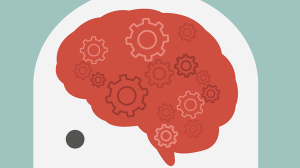4’33” (Four Minutes and Thirty-Three Seconds): What Our Brains Need

As my students know, their brains fascinate me and my colleagues. If they think about it, it is the only learning tool that they can never forget for our classes. Students can forget their homework, laptop, pencil or books. But there is no way they can forget their brain. But having their brain in our classes, on the athletic fields, or stage, does not mean learning or a strong performance will happen. Our brains are just not that simple and, at 3 lbs., the brain is pretty incredible and cannot be ignored.
Throughout this school year, I have been fascinated with memory, especially after reading Make It Stick: The Science of Successful Learning. All teachers should desire to have what they teach and have students experience, not just stay in their brains for a test, but also for a future moment when they might be at a social event and they need to recall who the Great Compromiser was in American history (Henry Clay) or who was LBJ (hopefully you will not say LeBron James).
But what do we ever truly remember? For example, why do we never forget how to ride a bicycle? Even if we have not done it in many years, most of us could get on a bike and head off somewhere without a problem. I went to Dickinson College. Recently, I was asked what one of my favorite college classes was and I recall it being Music 101 in which we listened and talked about the great symphonies in the context of the historical period in which they were written.
Most of you don’t know that I have a “man crush” on Bruce Springsteen and know the lyrics to nearly all of his songs. I also often claim that because of Music 101 I know all the words to Beethoven’s 5th and 9th symphonies (the latter actually has German words that I don’t understand), Mussorgsky’s “Pictures from an Exhibition” and Vivaldi’s “Four Seasons”. But there is one symphony that I was introduced to in that college class that is particularly memorable and pertinent to our brains. It is one that we should play more often in our lives as teachers, students, and parents. It is titled 4’33’’ and is delivered in three movements and was composed in 1952 by John Cage. Take a listen.
Our brain never stops working, even in our sleep. But it needs time to catch up, to think and ponder. But hardly do we, teachers, students or life, give it such “catch up” time. Have you ever wondered how much information a student’s brain receives each day, whether in class, at lunch, on the playing fields, or via social media. Our brains are constantly receiving, filtering, and pruning away information, making choices. We don’t need the next Taylor Swift or Bruce Springsteen song to calm our brains, we need 4’33’’ each day, a silent symphony, from which new ideas can emerge, opportunities can be evaluated, or momentary peace can be sought. Our brains deserve this and research shows that such a symphony is good for us. Moreover, this is a great time of year to make 4’33” a consistent part of your pedagogical practice. Let’s give students time to reflect on what they have learned this year, to assess the goals they established for themselves and their current progress, and what their current learning strengths or weaknesses might be. Or better yet, let's build silence into our instructional practice. After initially freaking out most students, they will probably come to appreciate and welcome each of the symphonies movements.
Therefore, my challenge for each of us is to make 4’33’’ seconds more a part of how we teach, learn, and live each day. Recalling the words are easy, the melody is catchy, and it is one symphony that all of us can actually play on any instrument of our choosing, even my personal favorite, the air guitar.
Thank for reading and hopefully remembering!